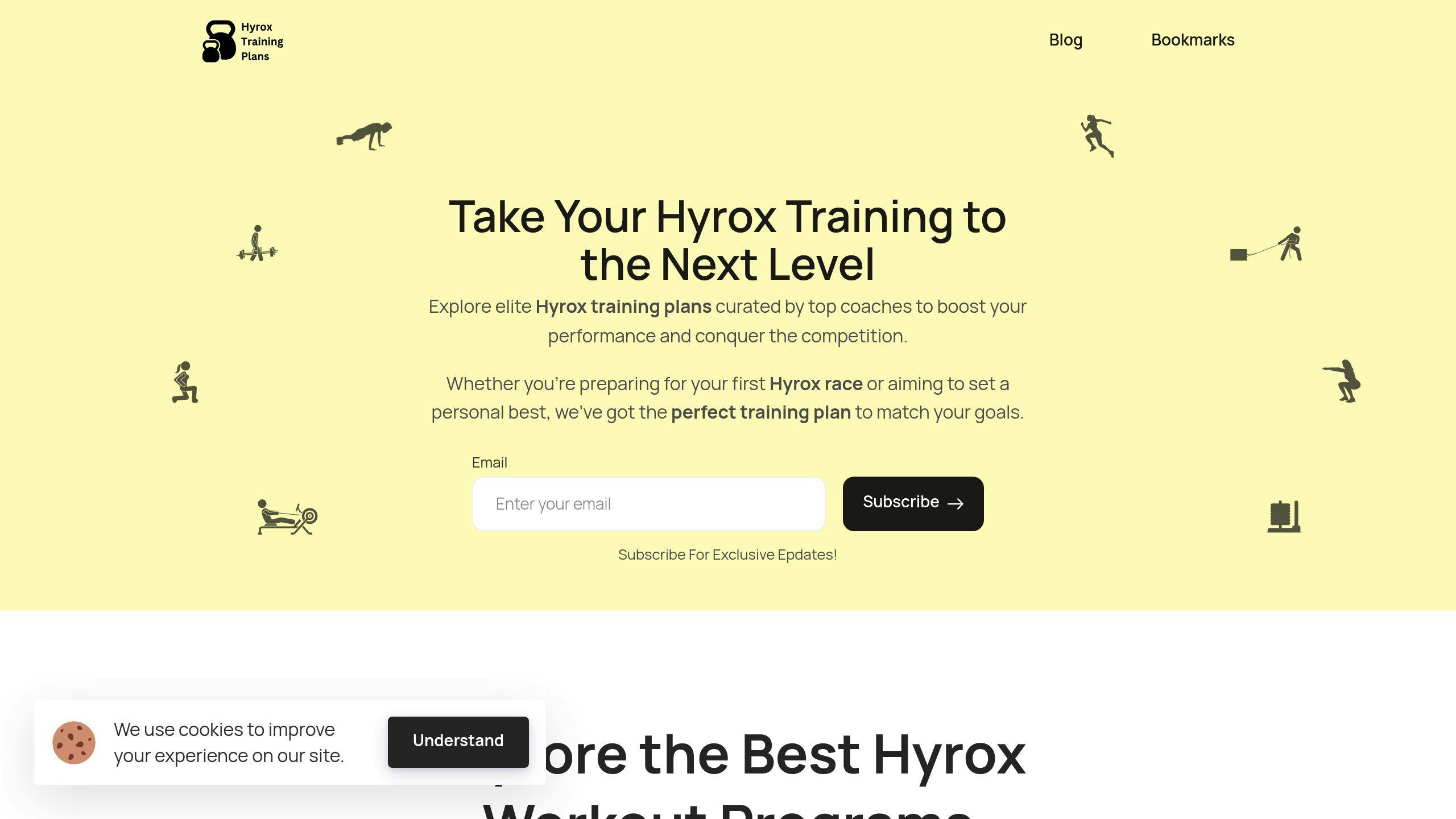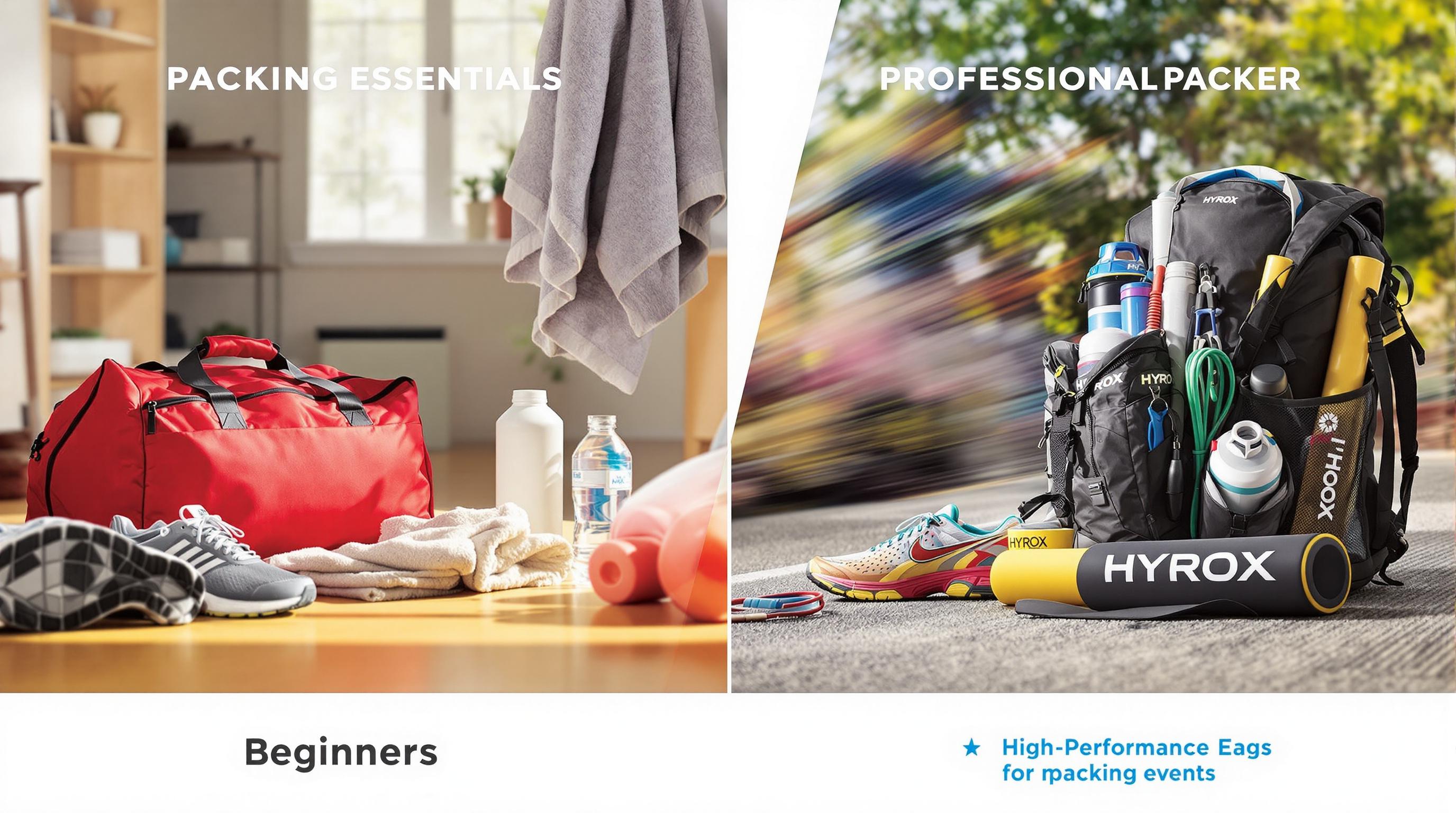Mastering Hyrox transitions can significantly improve your race performance. These transitions, the moments between running and workout stations, demand quick recovery, mental focus, and efficient movement. Small tweaks - like cutting 5 seconds per station - can save up to 40 seconds overall. Here's how to improve:
- Controlled Breathing: Use the "4-2-4" technique to stay focused.
- Active Recovery: Light jogging keeps muscles warm.
- Smooth Station Approach: Slow down 10-15 meters before a station to maintain momentum.
- Mental Prep: Use mantras like "Switch, breathe, go" and visualize transitions before race day.
- Drills: Practice with mock circuits, combining running and station tasks, to build muscle memory.
Focus on reducing rest, improving movement efficiency, and staying mentally sharp. Consistent practice and small adjustments can make transitions feel automatic and efficient.
HYROX Relay Transition Briefing

Strategies for Effective Hyrox Transitions
Nailing your transitions in a Hyrox race can make a big difference in your performance. It’s not just about physical readiness - mental focus and smart strategies are key. Let’s break down some effective ways to improve your station-to-station flow.
Reducing Rest Between Stations
Top athletes often rely on a "4-2-4" breathing technique during transitions: inhale for 4 steps, hold for 2, and exhale for 4. This helps control your breathing and keeps you focused. Pair this with active recovery - keep moving lightly as you approach each station instead of stopping completely. This keeps your muscles warm and your blood flowing, making it easier to dive into the next exercise.
| Recovery Strategy | How To Apply | Result |
|---|---|---|
| Controlled Breathing | Use the 4-2-4 pattern | Improves oxygen flow and mental clarity |
| Active Movement | Light jogging or walking | Keeps muscles loose and prevents stiffness |
| Strategic Hydration | Take quick sips as needed | Prevents dehydration without slowing down |
Improving Movement Efficiency
Smooth transitions come down to preparation and positioning. Start slowing down 10-15 meters before a station to adjust your pace while keeping momentum. This is especially helpful for stations with equipment like the SkiErg or rowing machine.
When you approach equipment, position yourself for immediate action. For example, with the sled push or pull, set up so you can engage the equipment right away. These small adjustments can shave off valuable seconds over the course of the race.
Mental Preparation Techniques
Your mindset is just as important as your physical readiness. Many athletes use simple mantras like "Switch, breathe, go" to stay in rhythm during transitions.
Visualization is another powerful tool. Before the race, mentally walk through how you’ll approach each station, set up equipment, and recover. This mental rehearsal can make your transitions feel automatic on race day.
For doubles events, communication is key. Use clear signals - like a tap or a quick call - to coordinate with your partner. Some teams even use hand gestures or vocal cues to keep transitions smooth without losing momentum.
Drills to Improve Transition Speed
Cardio and Stamina Drills
Boost your cardiovascular recovery with drills that align with the Reduced Rest strategies discussed earlier. Try this HIIT workout: 5 rounds of 400m run (at 80% effort) → 500m row (at 75% effort) → 30 seconds of active recovery. This combination helps build endurance and quick recovery capacity.
Functional Movement Drills
Use the positioning tips from the Improving Movement Efficiency section to enhance these drill combinations:
| Drill Combination | Protocol |
|---|---|
| Burpee to Broad Jump | 5 sets of 10 each (30s rest) |
| Sled Push to Farmer's Carry | 4 sets of 20m each (45s rest) |
| Wall Ball to Walking Lunge | 3 sets of 15-20 reps (30s rest) |
Focus on maintaining precise movement even when fatigued. Begin with lighter weights to nail down your transitions before ramping up the intensity.
Simulated Transition Workouts
Take the mock course strategies from Practicing Race Day Transitions and simplify them for targeted training.
1. Mini-Circuit Setup
Create 3-4 stations modeled on scaled-down Hyrox station tasks. Include:
- 250m run segments
- 250m SkiErg
- 10m sled push
- 15 burpee broad jumps
- 250m row
2. Workflow
Perform 2-3 rounds, concentrating on smooth transitions. Time each station change, aiming for transitions under 15 seconds. With practice, elite athletes can bring this down to under 10 seconds.
"The key to effective transition training is progressive overload", says a Hyrox Training Plans coach. "Start with circuits you can handle and gradually make them more challenging while reducing rest. This builds both physical endurance and mental toughness."
As noted in Mental Preparation Techniques, progressive overload is just as important for mental growth as it is for physical improvement.
sbb-itb-8bcd5e0
Practicing Race Day Transitions
Setting Up a Mock Hyrox Course
To create a realistic mock Hyrox course, arrange stations with about 40-50 meters of spacing to replicate race conditions.
Hunter McIntyre, a professional Hyrox athlete, advises: "The key is creating a space that mimics the actual race environment as closely as possible. This builds muscle memory and reduces race day anxiety."
This setup allows you to practice the 4-2-4 breathing technique and station approach strategies. It's an opportunity to put earlier breathing and movement techniques into action.
Adding Transitions to Your Training
Incorporate transition practice into your training routine by focusing on these core areas:
- Dedicated transition sessions lasting 60-90 minutes
- Short drills embedded in your regular workouts
- Video reviews to identify areas for improvement
Tracking and Improving Transition Times
Use tools like video analysis and timed drills to monitor your progress. Elite athletes typically complete transitions in 5-10 seconds, while beginners may take 20-30 seconds.
For measurable goals, refer to Hyrox Training Plans, which offer metrics to track your progress. These can be aligned with the progressive overload principles discussed in earlier sections to steadily improve your transition speed.
Advanced Techniques for Better Transitions
Strategies for Doubles Events
To excel in Hyrox doubles events, smooth coordination with your partner is essential. This requires clear communication and pre-planned strategies for transitions.
"Establish clear switching signals during practice, so that it is clear who steps where. Don't wait too long with switching, since it takes only a minimal time to switch, and you will regret it on the run when your legs get tired from jumping."
Here’s a quick reference guide for effective switching during key stations:
| Station | Switch Frequency | Key Benefit |
|---|---|---|
| SkiErg | Every 250m | Maintains rhythm |
| Sled Push/Pull | Every 12.5m | Balances fatigue |
| Burpee Broad Jumps | 3-4 total switches | Optimizes recovery |
| Wall Balls | Based on fatigue signals | Maximizes efficiency |
These strategies build on the communication skills discussed earlier in the Mental Preparation Techniques section.
Optimizing Equipment Use
Beyond basic positioning, advanced competitors focus on managing equipment for seamless transitions. Paul Richardson explains:
"I row first because I have bigger feet than my partner. That means that we don't need to loosen the straps for me too much for him to get out, and she can slide her feet in easier as we changeover."
Key tips for better equipment use include:
- Pre-adjust settings: Configure rowing machine foot straps and resistance levels before starting.
- Strategic placement: Keep hydration and gear within easy reach to save time.
- Quick-release gear: Use equipment that allows for fast adjustments between stations.
Effective Recovery During Transitions
Transitions aren’t just about speed - they’re also an opportunity to recover while staying active. Try these advanced recovery techniques:
- Dynamic Movement: Perform quick shoulder rolls or hip circles to stay loose without stopping.
- Energy Management: Use micro-rest techniques, like pausing briefly at the top of a wall ball throw, to conserve energy.
"Adapt these techniques mid-race based on fatigue and performance data."
Incorporate these methods gradually into your training to ensure a smooth transition from foundational skills to advanced techniques.
Conclusion: Mastering Transitions in Hyrox
Excelling at transitions in Hyrox takes a mix of physical training, mental focus, and careful planning. It’s about putting into action the positioning strategies and focus techniques discussed earlier. Use the breathing methods and equipment setup tips shared before to keep everything running smoothly.
The secret to mastering transitions? Paying attention to the small things. With consistent practice and fine-tuning, athletes can build muscle memory, perfect their equipment setup, and stay mentally sharp throughout the competition.
Incorporating Hyrox Training Plans

For those looking to step up their transition game, structured training is a must. Hyrox Training Plans offer a methodical way to improve, featuring progressive drills that build on the simulated workouts and equipment strategies mentioned earlier. These plans are designed to help you turn practice into race-ready skills, ensuring smoother transitions.
The platform combines drills focused on transitions with strength and endurance training, reinforcing the techniques and strategies detailed throughout this guide. This approach helps athletes prepare for every aspect of the race, from start to finish.



